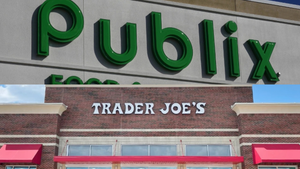A&P'S LABORS IN CANADAA&P'S LABORS IN CANADA
TORONTO -- A&P's Canadian division has never faced starker choices.Gerald L. Good, president and chief executive officer of the operation, told SN in an interview that noncompetitive wage rates are bleeding profits from the 239-store operation and handing it the most serious challenge it has ever faced."We're finding wage differentials of $6 to $8 an hour between ourselves and competitors," Good said.
June 13, 1994
DAVID ORGEL
TORONTO -- A&P's Canadian division has never faced starker choices.
Gerald L. Good, president and chief executive officer of the operation, told SN in an interview that noncompetitive wage rates are bleeding profits from the 239-store operation and handing it the most serious challenge it has ever faced.
"We're finding wage differentials of $6 to $8 an hour between ourselves and competitors," Good said. "It's that much! That translates into lower prices for the competition, which means they can take business away from you on a price basis. This
isn't about greed. We've lost money in the last two years in Canada. We can't continue to do that and stay in business."
For that reason, after 65 years operating in Canada, A&P's future north of the U.S. border may rest on the fate of current labor contract negotiations. And Good put forward two potential scenarios.
The first involves growth. The company, if it gains favorable settlements, plans to invest in its Canadian operation by pursuing some ambitious merchandising and capital investment programs. These include the continued rollout of private-label items and the devotion of some $35 million over the next three years to new stores and remodels. The other scenario involves a rethinking of the company's direction in Canada. The retailer, which recently emerged from a bruising strike that shut down 63 stores here for 14 weeks, is concerned about how it would compete if its high labor costs aren't brought in line with the lower rates of competitors. The big hurdle is the contracts expiring this month and in July for employees at its other 176 stores. Without a favorable result, Good insists the business would become increasingly difficult.
"This is the most serious time we've had in the history of A&P's experience in Canada," said Good, a 16-year veteran of the Montvale, N.J.-based A&P, who has headed the Canadian operations for the past two years. "We hope we're not backed into the corner where our only alternative is to close unprofitable stores," Good added.
The company's message has found acknowledgement in some union circles. One of the unions involved in the talks, the Retail Wholesale Canada division of the United Steel Workers, has been confirming the need for cooperation. A&P is far more concerned about a second contract under the United Food and Commercial Workers union. That pact, which is the first to come due, expires today. Under Ontario law, UFCW can call a strike as early as June 20. The bottom line in all labor talks for the $1.9 billion volume Canadian operation is wage comparisons. The company's unionized Canadian divisions -- whose banners include Miracle Food Mart, Ultra Food Mart, Dominion and A&P -- are fighting a growing array of competitors that have either nonunion contracts or low-wage agreements, Good said. Those dynamics make it difficult for A&P's units to stay on top of an increasingly price-competitive market.
Complicating A&P's challenge is the lack of resiliency in the local economy. "The Ontario economy hasn't recovered," Good said. "There's still a lot of pressure on the consumer, with employment not growing and significant tax increases. The economy is better in Western Canada. All of these problems have caused us to lose about 3,500 union jobs over the past five years in Ontario."
The company was in a strong position during the 1980s. From 1983 through 1989, income margins before interest and taxes averaged more than 3% and sales grew at an average rate of 15%. Those indicators plunged in the 1990s. Last year, income margins dropped to - 1.8% and sales fell 8.2%. The switch from profits to losses also happened fast. A&P showed earnings in Canada of $61.4 million in fiscal 1990. But profits fell to $5.3 million in 1991 and turned into losses of $38.7 million and $33.0 million respectively in 1992 and 1993. The recent 63-store strike by some 6,500 workers was spearheaded by two UFCW locals, the same locals involved in some of the current talks. The work stoppage, which ran from the middle of last November until late February, temporarily shut down the company's Miracle Food Mart group of stores, which include those under the Miracle Food Mart and Ultra Food Mart banners. These units were acquired by A&P from Steinberg Inc., Montreal, in 1990. A&P was forced to close the stores because a new Canadian strike law prohibited the retailer from hiring replacement workers. The strike dealt a blow to A&P's corporate results. It reduced the company's profits and hurt sales in the fourth quarter ended Feb. 26, contributing to the overall corporate loss of $19.4 million in that period. Specifically, the strike's effects shaved earnings by about 57 cents a share -- or $21.8 million after taxes -- in the quarter, the company said.
Good said he is confident the contract inked in February will give A&P the leverage it needs to be competitive with the Miracle Food Mart group. The terms included a wage pullback of $1.75 (Canadian) an hour, the closing of one store, and buyout programs and layoffs resulting in the departure of about 700 full-time and 1,500 part-time employees, according to Good.
But also part of the pact was a loosening of rules that Good said will further help A&P compete.
"We simplified a lot of the restrictive work rules in the old contract and made them comparable to more junior contracts in place," he said. But A&P won't have much time to celebrate its contract. It now faces a test of greater magnitude with its A&P and Dominion stores in current contract discussions.
"We're not looking for exactly what we got in Miracle Food Mart, but we are looking at some big wage differentials in these groups vs. competitors," said Good, who wouldn't go into specifics.
In the contract that expires today, two UFCW locals are representing 10,000 employees at 103 A&P stores. Stressing his concerns about this negotiation, Good said these A&P stores are the most problematic in terms of wage disparities with competitors. Moreover, sources said there is still a lot of bad feeling between the company and the union, which reportedly saw the Miracle situation as a forced settlement.
In an interview with SN, Ron Springall, the UFCW spokesman in these talks, said while he is hopeful the parties can reach agreement, the company has been unclear about what it is seeking.
"They need to identify exactly what they're looking for from the union," he said. "All they've come up with so far is vague proposals.
"Right now they're like a kid in a candy store looking for candy."
In the other labor negotiation, the Retail Wholesale union is bargaining for some 7,000 workers regarding a contract that expires July 2. It affects workers at 35 Dominions, 29 A&Ps (which were formerly Dominion units) and nine stores under different banners. All of the 73 stores in this bargaining group were acquired from Dominion in 1986. Clearly, this should be the easier contract negotiation, according to both parties. The two sides came closer together two years ago in their most recent talks.
"At that time we agreed to take a group of troubled stores and loosen their way of operating," said Tom Collins, Canada director of the Retail Wholesale union. "We allowed for more flexibility in areas like increasing employee hours. In return, A&P kept those stores open and invested in renovations. I'm hopeful we can work it out this time."
Collins said the No. 1 issue for his union's negotiations will be job security. In addition, the union will push for inflationary wage increases of about 3%, he said. Good maintained he is optimistic about all of the labor hurdles, but he underlined the importance of the outcomes. "I hope the union leadership and people will understand that if we go away, there's no jobs. We have to work together to solve the problems."
A&P is hoping its major focus in a few months will be merchandising and store-unit expansion rather than labor costs. It recently kicked off a poststrike marketing and advertising program at the Miracle Food Mart group with the focus on sharper prices. Also in the works are remodels for some facilities, Good said.
For its Canadian operations as a whole, A&P is well under way with a number of merchandising and expansion programs. They include:
Premium-Quality Private Label: The company is continuing to roll out more products under its premium-quality Master Choice private label, which is even more extensive than the analogous U.S. program. A&P added some 150 stockkeeping units in the past year to bring the label up to 500 SKUs in Canada, and is now working on some additional 150 items for the near future.
Conventional Store Labels: A&P is moving ahead to consolidate its conventional store-label products under a single brand called Equality. This label will replace brands such as Dominion, A&P and Miracle Food Mart within Canada. A similar program is being conducted for U.S. stores under the America's Choice label.
Square-Footage Expansion: Two-thirds of the new three-year capital expansion program of $35 million will be devoted to renovations, and the remainder for new stores. Four stores will be built in the current fiscal year and at least that many will be constructed next year.
Customer Loyalty Program: A&P is the only Ontario retailer to employ a frequent-shopper program, which has been expanded to all of the company's units in Canada. The program, which has allowed the stores to eliminate couponing, has been very popular. Will all these programs be enough to ensure A&P's continued viability in the turbulent Ontario market? Some financial analysts say the company will probably make the best of a very difficult situation.
"Their hands are tied up there with the unions and the rules on replacement workers," said Ed Comeau, senior vice president at Lehman Bros., New York. "I don't know if successful labor contracts will provide for long-term growth, but they would bring a more stable footing. It should help the company bring profits. "Most importantly, if the Ontario economy turns around, they should be in better shape. Not as good as in the mid-1980s, but better than the loss-making position of right now."
The State of the Unions
All of A&P's labor agreements in Canada are being renegotiated this year. Following is a breakdown of completed and pending negotiations for the company's 239 stores:
# OF MAIN CONTRACT
STORE GROUP STORES BANNERS EXP. DATE UNION
Miracle Food 63 Miracle Food Mart, 6/21/93 UFCW
Mart Ultra Food Mart
The union staged a 14-week strike beginning last Nov. that shut down stores until Late Feb., when a settlement was reached.
A&P 103 A&P 6/13/94 UFCW
The company said it is very concerned about this contract because the A&P employees' wages are out of line with the lower-wage compeition. Also, the relationship between the company and the UFCW may be strained after the recent prolonged strike at the Miracle Food Mart group of stores, according to sources.
Dominion 73 Dominion, A&P 7/2/94 RWU
The talks will focus on wages and job security. The two parties have been building a cooperative relationship and are relatively optimistic.
About the Author
You May Also Like




